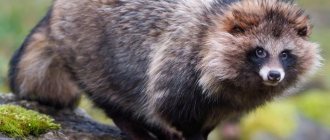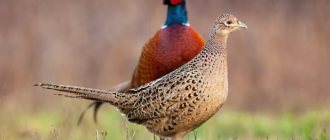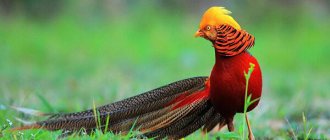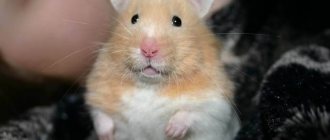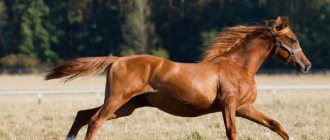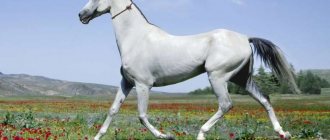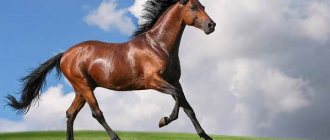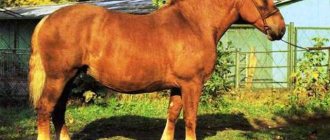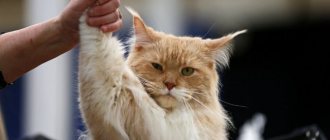Thoroughbred - a breed bred in England. Initially these horses were called English racing horses, but due to the fact that they began to be bred in most countries of the world, it was decided to change the name of the breed. Representatives of this breed are the fastest horses in the world. At short and medium distances they reach speeds of more than 60 km/h, and at long distances (more than 3 km) – 55 km/h. Horses of other breeds do not take part in races together with thoroughbred horses - they do not have a single chance to take a worthy place, because... running speed is incommensurable. The record holder for speed among thoroughbred horses is the stallion Beach Rakitu, who reached a speed of 69.69 km/h over a distance of 409.26 m.
Main characteristics of the breed
Origin: England
Suit: all one color. The most common are red, bay and brown. Black, gray and roan are also common.
Height at withers: variable. There are both very short (no more than 1 m 42 cm) and very tall (more than 1 m 72 cm) purebred riding horses.
Exterior: also varied. The best representatives of the breed have a magnificent stature, a dry head, an elegant neck and an intelligent look of large eyes. The shoulders are set obliquely, the body is short but powerful. The chest is deep, muscular croup, firm smooth legs. Minimum pastern girth (20 cm), powerful hocks, well-set tail.
Use: in equestrian sports, sport hunting, steeplechase racing, eventing.
Features: the fastest and most expensive horses in the world. They have a larger lung capacity and a more powerful heart compared to representatives of other breeds. But thoroughbreds are not the most durable horses. Stallions do not often live to be 23, and mares do not often live to be 20. They are very demanding regarding the conditions of care, feeding and maintenance.
Story
The English purebred horse breed appeared at the end of the 17th - beginning of the 18th centuries. Colonized England needed fast and hardy horses. There were many wars. Horse racing also became popular. It was decided to breed a breed that would meet all the requirements.
Breeders selected horses that performed best in equestrian competitions and crossed them with each other. Mostly local horses with eastern and Spanish roots.
This is how, by mixing the best with the best, the fastest horse in the world was born.
To this day, this breed is kept in suitable conditions, fed the best food, and its gene pool is constantly improved.
By the way, only those individuals that are included in the list of purebreds are allowed to mate. This is how they make sure that the blood of another breed does not interfere and does not disrupt the long work of the breeders, which brought an impressive result.
Origin of the breed
The origin of the breed dates back to the 17th-18th centuries, when the creation of an ideal breed by the method of strict selection began in England. Individuals who took first place in the races took part in the selection. For selection, mares were selected from the royal studs. These were mainly Hungarian, Spanish and Oriental breeds of mares, of which 50 became progenitors. The stallions mainly came from Arabian racing breeds, but a small part of the admixture also came from Turkish, Turkmen and Barbarian stallions.
Of the eastern stallions that gave rise to the English breed, three became known. The first, nicknamed Turk, was taken as a trophy by a British captain. Despite his origins, the horse was an Arab and became a wonderful sire. The second - Darley Arabian - became the father of 2 famous foals, which played an important role in the development of the breed. The third progenitor of the famous breed is the Godolphin Barb, born in Yemen. This horse produced many famous horses in England, including the famous racehorse Les.
Appearance: aristocratic power
The English Thoroughbred is known for its beauty and gracefulness.
- She has large expressive eyes, a long neck, a classic head shape, large nostrils, small ears.
- Massive body, deep chest, muscular croup.
- Long, very durable limbs, which is not surprising for the fastest horse in the world.
- The body is short, but tall.
- The average height at the withers is 160 cm.
- Strong muscles.
- The bangs and mane are not very developed, the tail is sparse, and the fur is thin.
- Single color color. Mostly red, bay and brown. Sometimes gray is found.
- Weight on average 500 - 600 kilograms.
- Lives 20 - 23 years. Stallions usually live a little longer than mares.
English racing horse in Russia
Purebred English horses were brought to Russia at the end of the 18th century. Already in the second half of the 19th century, horse racing with their participation appeared. The horses were mainly used to improve local breeds.
As mentioned earlier, these animals were used to breed the Oryol trotter. For this they were involved by A.G. Orlov-Chesmensky. But subsequently, stud farms appeared where English racing horses were bred.
When the first racing community appeared in Russia (1825), horses became increasingly popular among local breeders. Thus, in 1826, the second volume of the English stud book was republished in Russia, and eight years later the Moscow Racing Society was organized.
You will probably be interested in reading about how long pregnancy lasts and how to give birth to horses.
Two years later, the first volume of the stud book of purebred horses, which had already been born and used in Russia, was published.
Character
The appearance and achievements of the English breed of horses evoke admiration, but the same cannot be said about the character. In their youth, they can show impudence and unbridledness. Sometimes it takes a long time for the coach to find an approach to her. Under no circumstances should a horse be offended, much less beaten. Affection and moderate severity are the key to gaining trust. Over time, the severity of the character disappears completely.
However, the character is lively and energetic. And although sometimes there is a tendency to become blue, you are guaranteed maximum performance from the horse. Character is determined by pedigree, but much also depends on upbringing.
Arabian horse breed: Arabian horses
One of the oldest horse breeds, bred in the central regions of the Arabian Peninsula in the 4th-6th centuries. AD Scientists believe that it was based on horses of North African and Central Asian origin. Arabian horses were raised in difficult conditions of deserts and semi-deserts, and strict requirements for working qualities were imposed on them.
In the formation of the breed, a major role was played by the constant wars of the Bedouin Arabs, who used these horses as military horses. As a result of such specific selection, with excellent care and feeding, a medium-sized, tightly knit horse appeared, very hardy and playful at a gallop, with excellent movements at all gaits. For a long time, Arabian horses were the most valuable wealth of local nomads.
In Europe and other continents, the first “Arabs” appeared at the beginning of our millennium. The wars waged by the crusaders showed the advantage of the agile and tireless Arabian horse over the heavy and clumsy horses of the English and French knights. These horses were not only playful, but also beautiful. Since that time, in European horse breeding, the blood of Arabian horses has been considered beneficial for many breeds.
Thanks to the Arabian breed, such famous breeds as the Oryol Trotter, Russian Saddlebred, English Saddlebred, Barbary, Andalusian, Lusitano, Lipizzan, Chagia, Percheron and Boulogne draft were developed.
Currently, Arabian horses are widespread in the world. To coordinate breeding work with this breed, the World Organization of Arabian Horse Breeding, uniting 60 countries, was created.
Modern representatives of this breed have a height at the withers of 140 to 156 cm. A small graceful head with a wide forehead and a wedge-shaped tapering towards the muzzle, with a concave (pike) profile, with expressive bulging eyes and large nostrils capable of greatly expanding.
High-set neck with a slight swan curve. Clearly defined withers. The back is of medium length, wide and level. The chest is wide and round, with well-developed false ribs. Slender, like chiseled legs, very strong, with strong hooves. A special difference between representatives of the Arabian breed and other horses - in addition to the pike head and large eyes - is the so-called “cock” tail, which they raise high (sometimes almost vertically) at fast gaits.
Horse colors are mostly gray of all shades (with age, such horses often acquire “buckwheat”), bay and red, less often black.
Among purebred Arabian horses, four types of exterior can be distinguished:
1. Siglavi - elegant horses with a clearly defined breed, with an average body constitution, short stature, they are lighter and less frisky in racing;
2. Koheilan - more massive horses with a strong constitution, with powerful and wide bones and developed muscles, broad-chested, hardy, excellent horses;
3. Hadban - they are distinguished by the least pronounced eastern breed, but they are the largest horses in the breed, frisky, hardy racers and sports horses;
4. Koheilan-siglawi is a mixed type, combining the elegant, dry forms of the siglavi and the massiveness of the koheilan; this type is also distinguished by its taller stature and high performance.
Arabian horses are primarily used for racing and trail riding, as well as recreational riding horses.
Maintenance and care
Proper maintenance of this breed requires compliance with many conditions, time and money. The horse is very demanding of care.
- The stable should be warm and comfortable. The area per unit of the stall should be from 50 m2. It is desirable for each to have personal access to the lawn. Floors should be dry and the room should be well ventilated. Promptly remove manure and clean the premises as a whole. It is very important to provide the horse with a comfortable temperature regime. To do this, you will have to install heating into the room. This will incur considerable costs, but the comfort of a champion who will bring you victories is worth it.
- Proper bedding is also an important maintenance condition. Hay, sawdust or peat are best. They are not only easier to clean, but also absorb unpleasant odors well. The litter should be on average 30 cm thick. The bedding needs to be replaced 2 times a day and the stall must be disinfected once. As for feeders and drinkers, they need to be cleaned as soon as contamination is detected.
- Horse grooming should be done regularly. Maintaining hygiene is the key to the health of a thoroughbred horse. The skin must be cleaned every day. To do this, use warm water, a special brush and a comb. The sensitive skin of this breed requires delicate cleaning products.
- Check teeth and hooves regularly.
Possible diseases of horses
There are diseases such as thinning of the walls of blood vessels, so during exercise there are quite severe nosebleeds. Horses are very susceptible to injury, with hoof and leg injuries being especially common. Such horses must be kept in a separate enclosure, the size of which must be at least 50 square meters. m, preferably with a separate exit to the lawn. Enclosures must be insulated, as horses do not tolerate frost well.
The horse needs to be bathed, and massage is also extremely important for it. The harness used must be made only from high quality materials. These horses, even with good care, only live to be 20-25 years old. To protect horses from possible problems, you should take your pets to the veterinarian, even when nothing is bothering them, just for a routine examination. Another option is to invite a specialist directly to the stable to examine all the animals.
Feeding: everything is individual
For each individual, the diet is selected personally. Age, weight, health status and stress are taken into account. The food contains all the necessary elements. It is especially important to ensure the availability of calcium and phosphorus.
A horse of this breed is fed hay, special feed, and vegetation. You also need to encourage the animal with apples, carrots, beets and potatoes.
Feeding is done 3 times a day.
For an average weight individual, 12-14 kilograms of food are needed per day. Give at least 40 grams of salt per day.
Fish oil and vitamins are usually added to the water. In summer, the volume of water drunk per day is approximately 50 liters, in winter - 30.
What is the purity of the breed line?
According to modern classification, purebred breeds are considered:
- Arabic;
- English riding;
- Akhal-Teke.
Attention! In English-language sources, Barbary horses of eastern origin are also included in this group.
The term “purebred” means that the breed lines are bred exclusively “in themselves”, without the infusion of other blood. The stud books of these species have long been closed, and further selection is carried out in purity.
Where is the English Thoroughbred horse used?
The main purpose of the English breed is horse racing and hippodrome racing. The horses are so fast that other breeds have virtually no chance of winning. Therefore, competitions are held only between representatives of this breed.
They are well suited for sport hunting and polo.
English purebreds are not used en masse, for example, in agriculture, due to their high cost and inability to adapt to other types of activities.
Competitions and cost of the breed
An English thoroughbred racehorse is not only beauty, grace, speed, but also huge sums of money. The cost of purebreds starts from 250 thousand rubles. The record price paid for such luxury was $40 million, which was paid for the famous trotter named Sharif Dancer in 1983.
Equestrian sport has long been considered a sport for the elite. Horse racing is not only about huge prize money, but also about prestige. The richest people on the planet shell out huge amounts of money in order to take part in races and win a big prize, so many millionaires invest their savings in this particular type of horse.
The most famous horses of the breed
- In first place is the already mentioned stallion Sharif Dancer; $40 million remains to date the record amount paid for a representative of this breed.
- In second place is the record holder named Colleen, who has won 15 times in a row. Since 1908, she was considered invincible at the races; legends about this horse continue to this day.
- In third place is the indestructible thoroughbred stallion named Fighter, who scored 50 victories in 8 seasons. He took part in almost a hundred races.
- In fourth place is a horse named Chocolate Soldier, whose 51 starts ended in victory. In addition to his numerous victories, the stallion became famous thanks to his unusual coloring.
- In fifth place is the trotter Manowar, an American horse who has won 21 races. A stallion of a purebred English breed.
- In sixth place is a horse named Kant Flint, she brought victory 25 times and became the champion of her country three times.
It is obvious that the English Thoroughbred variety of horses is extremely popular, it continues to be a favorite at any race, and if the purpose of acquiring a horse is to participate in races, you will not find better than it.
Still there are disadvantages
This breed has always been kept in conditions close to ideal. They were never deprived of attention and care. This could not but affect their vulnerability.
- The mild climate in which they were grown had a very big influence. Because of this, they are very susceptible to temperature influences. English purebreds cannot tolerate cold or too hot weather.
- Low immunity is also a big disadvantage of this breed.
- Pickiness in food is also characteristic of these horses.
- Low fertility of mares causes big problems for many horse breeders. Often there are individuals who are completely unable to reproduce offspring.
Usage
English thoroughbreds are used for riding and racing. The latter can be either for a racetrack track or for barriers. Horse racing can also be conducted over rough terrain (stillchase).
English racing horses are also popular for cross-country. Horses that do not perform well in racing may be used to breed or improve other breeds.
Interesting things about champions
- Thoroughbred horses are the most expensive in the world. The record amounts for which they were purchased were 13, 16 and 40 million dollars!
- The stallion Dino, raised in England, had the longest mane - 3 meters. We remember that this breed is not hairy, but rather the opposite.
Stallion Dino
- The stallion Colin participated in fifteen races during his career and was the winner in all of them.
- Beach Racket reached the highest speed known in the world of horse racing - 69.69 km/h.
A lot of time and effort was invested by people working on breeding purebred horses. The result paid off. Thanks to this breed, many varieties of equestrian sports were created. They showed the limit of possible speed and brought countless victories and joy to their owners.
The price of English thoroughbred horses starts from half a million rubles.
horse
Purebred breed is ideal for equestrian sports
Since the formation of the purebred English racing variety as a special population of horses, breeding records have been required. So, the first census began in 1793, only purebred individuals were recorded in it. Since then, horses whose both parents were recorded in this book have been considered purebred. Regardless of the fact that this variety is considered one of the best racing horses all over the world, the requirements for competition participants are always increased.
Before the races, participants are carefully examined both externally and internally, and an ultrasound examination of the horse’s internal organs is performed. Each horse is necessarily assessed for endurance, physique, and health. In addition, the individual must have parents entered in the breeding book. The English thoroughbred horse easily passes all these tests and is among the first contenders. This breed is considered irreplaceable for equestrian sports.
What qualities do purebreds have?
Horses bred with pure blood are characterized by exquisite beauty and grace. Their character cannot be called calm. These are proud and wayward horses; they require a special approach. For example, English horses are famous for being difficult to train precisely because of their fiery temperament. Only an experienced person can ride them.
Akhal-Teke horses are known as proud animals that demand respect. They do not obey strangers, they do not even allow them to approach them, but they show devotion to their owner. Arabian horses have endurance and tenacity. These are their predominant character traits. Thanks to them, horses are able to win races when competing with representatives of the English riding breed. The latter run faster, but get tired faster.
Common Health and Behavior Problems in Thoroughbred Saddlebred Horses
Thoroughbred horses are susceptible to a variety of health problems, many of which are related to the fact that they are bred for racing. Because they are often pushed to their limits on the race track, the risk of health complications and accidents such as fractures is very high for Thoroughbreds.
This breed is also susceptible to exercise-induced pulmonary hemorrhages or bleeding in the lungs from intense exercise.
Additionally, some purebreds have abnormally small hearts, which can contribute to circulatory problems. And some individuals have hooves that are too small for their body size, which can cause pain and lameness.
Behaviorally, many Thoroughbreds are too energetic to be suitable for novice riders. But they are very smart. A confident, experienced trainer can often teach this horse to excel in a variety of equestrian sports.
However, former racehorses can be particularly difficult to retrain for other purposes, including general riding. These horses have been conditioned to race their entire lives and are often spooked by loud noises that remind them of starting pistols. Additionally, ex-racehorses typically only have basic behavioral training.
